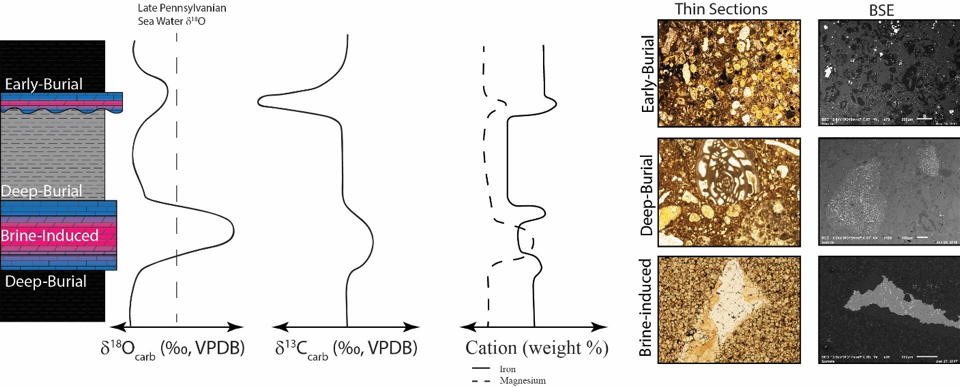My group is working on a range of projects in collaboration with Pioneer Natural Resources to understand potential correlation markers, model water chemistry during fluid injection, and understand the role of diagenesis.
Carbonate Diagenesis in the Wolfcamp Formation, West Texas
Proposed framework for carbonate diagenesis in mud-rich depositional environments. The lithology in the schematic strat column follows the legend in Fig. 3. This framework consists of three parts: geochemistry, petrographic images, and backscatter SEM images. Stable isotope analysis of carbon and oxygen in carbonates can provide preliminary evidence for which processes are influencing diagenesis in the study area. Further evidence will be provided through bulk geochemistry such as iron and magnesium concentrations. The relative change in both isotope values and bulk geochemistry will be partially controlled by the position of the study section in the basin. The second section, petrographic analysis, will show whether the diagenesis was fabric retentive as shown in the early- and deep-burial images or fabric destructive as seen in the brine-induced image. Finally, the third section, backscatter SEM imaging, will show if there have been multiple phases of diagenesis influencing the geochemistry of the system. By coupling this framework with the trends in isotopic values shown in Fig. 1, it should be possible to elucidate the processes influencing carbonate diagenesis in most mud-rich depositional environments.
As carbonate rocks are buried, fluid movement and bacterial reactions can result in changes in the rock composition and structure. By using a suite of geochemical tools, the history of these alterations can be determined. This research provides a framework for determining carbonate alteration in mud-rich environments, specifically the Wolfcamp Formation of West Texas.
Manuscripts:
*Reis, A., Erhardt, A.M., McGlue, M.M., Waite, L. (2019) Evaluating the Effects of Post-Depositional Alteration of Carbonates on the Interpretation of d13Ccarb and d 18Ocarb in a Mud-Rich Depositional Environment: A Case Study from the Midland Basin, USA. Chemical Geology, 524, 196-212.
Conference Presentations and Papers in Prep:
Erhardt, A.M., *Reis, A., McGlue, M., Waite, L., 2018. Evaluating the Effects of Post Depositional Alteration of Carbonates on d13Ccarb and d 18Ocarb in a Mud-Rich Depositional Environment: A Case Study from the Midland Basin, USA. American Geophysical Union. Oral Presentation
*Tamakloe, F., Erhardt, A.M., McGlue, M.M., Waite, L. 2019. High-Resolution Chemostratigraphic Analysis of Wolfcamp D Shale-Unit in Upton and Midland Counties – Is it possible to identify stratigraphically significant surfaces using d13Ccarb? American Association of Petroleum Geologists Southwest Chapter Meeting. Poster Presentation.
Modeling Fluid Flow in the San Andres Formation, West Texas
Using isotope analysis and geochemical modeling, we are working to characterize how fluid flow of injected water is influenced by existing diagenesis.
*Avery, E., Erhardt. A.M., 2018. Effects of injected waste water on a heterogeneous system. Geological Society of America. Poster Presentation.
Figure 1. During hydraulic fracturing, oil and produced water are flushed out of the well. The water is often disposed of in injection wells.
Figure 2. Geochemical characteristics of formation, produced, and disposal waters.





